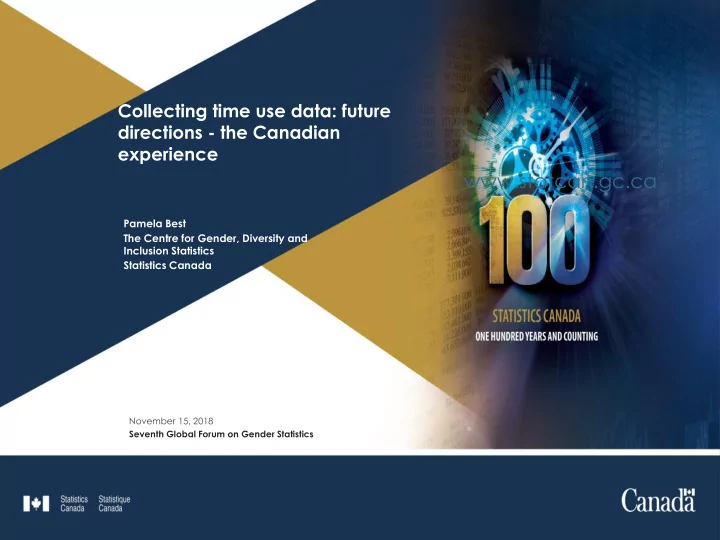

Collecting time use data: future directions - the Canadian experience www.statcan.gc.ca Pamela Best The Centre for Gender, Diversity and Inclusion Statistics Statistics Canada November 15, 2018 Seventh Global Forum on Gender Statistics
Overview ➢ A brief history of time use ➢ The General Social Survey on Time Use ➢ Adapting to changing collection techniques ➢ Examining the mode effects ➢ What we learned in 2015 ➢ Moving forward – GSS Modernization 2
Time use and unpaid work in Canada Statistics Canada estimates that 1971 household work represents 41% of Canada’s GDP Estimating the Value of Unpaid Work in 1978 Canada published 1981 National pilot of time use study Questions on unpaid work added to the 1996 3 Census
The General Social Survey on Time Use Time Use data are collected as part of the Canadian General Social Survey program (GSS) • The GSS program runs yearly and cyclically collects information on different topics Time Use, Victimization, Caregiving and Care Receiving, Families, Social Identity and Giving, Volunteering and Participating • Time Use data are collected every 5 to 7 years (1986, 1992, 1998, 2005, 2010 and 2015) 4
How do we collect time use data? Roster used to determine respondent Respondents assigned a reference day when the sample is created Complete a retrospective 24-hour diary of day-to-day activities Location of the activity and who they were with 5
How do we collect time use data We also ask: household composition, labour force status, life satisfaction, unpaid work, time perceptions and pressures, and participation in sports and cultural activities ….along with numerous socio economic characteristics . 6
Evolution of the instrument • Initially in 1986 used 84 activity codes, increased to 264 in 2010 • 2010 also collected simultaneous activities • 2015 used Electronic Questionniare for the first time • 64 activity codes (use of a light diary) • New mode of collection could not adapt to past 3-tier activity coding • Up to 2 pre-defined simultaneous activities were collected with each main activity (but not duration) 7
What we learned in the qualitative analysis of the 2015 pilot survey CATI VS Electronic Questionnaire Mode effect 8
Respondent characteristics CATI respondents Electronic Questionnaire respondents 84% had at least a high school diploma 97% had at least a high school diploma 31% had a University degree or more 47% had a University degree or more 49 % were working 54 % were working 19% had a child in the household 18% had a child in the household 8% were aged 15-24 3% were aged 15-24 9
Qualitative results of the pilot survey Reference day distribution EQ respondents CATI respondents ➢ highest number of completed ➢ highest number of completed diaries diaries ✓ Monday ✓ Tuesday ✓ Sunday ✓ Wednesday ✓ Saturday ✓ Friday ➢ lowest number of completed diaries ➢ Lowest number of completed diaries ✓ Wednesday ✓ Saturday ✓ Tuesday ✓ Sunday ✓ Thursday ✓ Monday 10
2015 Collection Issues • Telephone frame no selected respondent • Priority rules applied • Rostering process limited EQ •EQ acceptance ≈ disguised refusal • Additional script added • Collection started with CATI only 11 • Migration to a new EQ system version
Statistics Canada transformation Moving beyond a survey-first approach with Responsive new methods and integrating data from a variety of existing sources User- Making data easier to access and use by centric adopting new tools to analyze and visualize data Enabling Canadians to use data to Relevant make evidence-based decisions Enabling efficient data management and access 12
The General Social Survey – Why Modernize? • Today’s reality is one of rapidly changing and increasingly complex economies and societies, driven by a data revolution, ingenuity and innovation • This has led to the proliferation of data and data providers and increased user expectations and demand for micro/detailed data in real-time • Statistics Canada is renewing and modernizing to address these challenges, a process based on five pillars: Sharing and User-centric Leading edge Statistical Modern collaboration service delivery methods and capacity workforce and data integration building and flexible leadership workplace 13
2018-2019: Using EQGS 3.2.3 to conduct Time Use “Evolutionary” experiments vs. Test # 1 Reference day Yesterday Method Test # 2 vs. Targeted Age-order respondent selection vs. vs. No incentive Test # 3 Carrot Incentive Historical data incentive vs. vs. Test # 4 Email Letter SMS 6 reminders reminders reminders
Is there an app for that? DIARY MOBILE APP (with on-the-go collection (with seamless integration into functionality) web application) GEODATA ESM (with potential to incorporate beacon (Experience Sampling Method with and geo-fencing technologies to random time-triggered questions on subjective-wellbeing) trigger surveys) VOICE RECOGNITION MACHINE LEARNING (respondent data entry) (for coding) 9
Contact Pamela Best Assistant Director The Centre for Gender, Diversity and Inclusion Statistics Social and Aboriginal Statistics Division Pamela.Best@Canada.ca 613 301-8112 www.statcan.gc.ca/gender-diversity-inclusion www.statcan.gc.ca/genre-diversite-inclusion 16
Recommend
More recommend